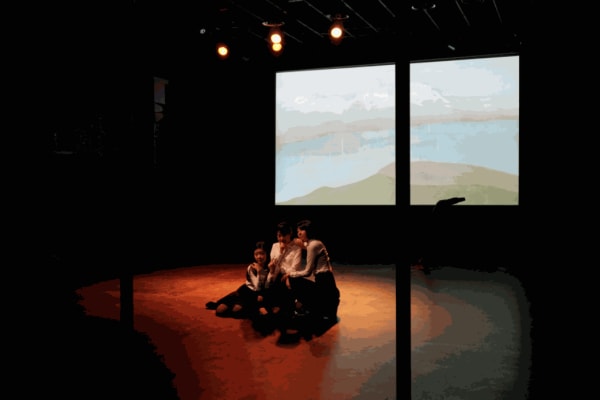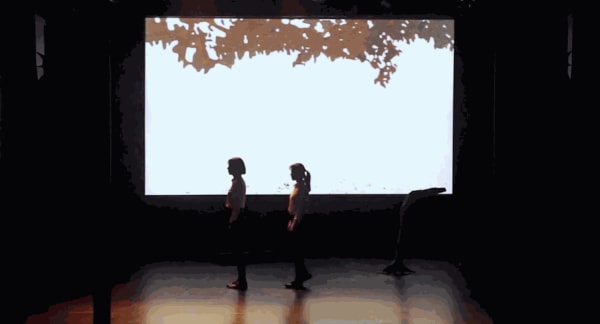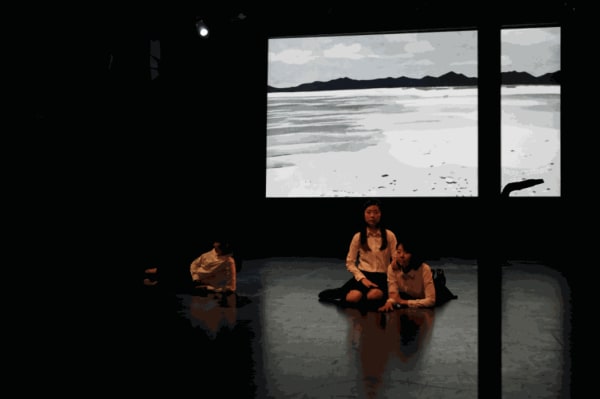By Haejin Kim
The first thing I noticed when I entered the theatre were the several columns that had been placed in front of the audience. ‘What could that be?’ The stage was still dark and only some rosy lighting illuminated the columns and seats. Before long, as the stage brightened, an image filled the wall facing the audience. At that moment, the columns became ‘something’, as they caught my eyes looking at the stage. By obstructing sight, the columns constantly reminded the audience that they were engaged in the act of ‘seeing’. On the other hand, they helped with the act of ‘seeing’, by functioning as a device to prevent us from being drawn into the landscape. Perhaps ‘seeing’ is just that – something that requires distance. Is this the reason why the girls – who had been looking at something or somewhere with their backs to the audience – came out of Sunny Kim’s painting?
The image that fills the entire screen slowly begins to move and transforms into another image, just as the thin fog outside the image changes its color corresponding to the delicate changes of the stage lighting. It looks as if fog is flowing into the painting, and also as if the fog in the painting is escaping out to the stage. The image continues to change. It is a transformation and at the same time, a disappearance. Images are disappearing into other images. This performance titled ‘Landscape’ mulls over paintings by putting them in motion. What came about from this struggle?
Performers. Navy skirts, white shirts, socks that rise up to the knees, and black shoes, all of which that reminds us of school uniform are neatly clad. Three performers become the school girls and gaze at the image. The performers’ movements become more active and the audience’s eyes begin to wander all over the theater including the screen. However, the performers were carefully controlling their movements as well as their sounds as if to protect themselves from being fully exposed. The girls sometimes would suddenly stop moving like statues as if they are part of the still image, or sometimes would all of a sudden halt their dash toward the audience making it look like the images on the screen had come to a stop. At that moment, it felt as if their bodies had been flattened by some invisible glass wall and had turned into paper dolls. And rather than being heard individually, the sounds of their voice are made collectively by them all and echo throughout the theatre as a chorus. The actors in this performance, instead of coming alive as characters, cleverly function within the space as if knights on a chessboard.
The girls, who appeared in front of the audience, are a product resulting from the artist’s struggle to transform the two dimensional space of the painting into a three dimensional space. None of these girls have individuality. We are staring at a body realized from an idea. The girls exit from their vague memories and play out a moment in time like ghosts.
The girls also take apart syllables from a poem and utter them without order. At first, I tried to make sense of what was being said, but gradually began to just observe the process of the language turning into meaningless ‘sound’ and dispersing through the space. It was quite different from being able to picture the image in my head when listening to Kim Sakkat’s poem recited by the performers earlier. A substance known as language had been visualized and was transforming into a landscape that I had never experienced before.
In ‘Landscape’, the eyes of the audience shift, like crossing a stream on stepping stones, from images on the screen, to mirrors and trees that had been placed, then to performers’ domain, then columns, and finally to the performers beyond those columns, in that order – outward starting from the innermost part of the theatre. “Landscape” in fact pushes and expands its space, little by little in an inverse perspective form, toward the audience.
In the last scene, a performer crosses the point beyond columns and takes a step forward towards the audience. At this moment, the space in which the performer roamed and ran, emerges along with the performer. Possibly because the performer is looking up into the void, the space brought out by the performer and that of the audience do not confront or compete. Instead, these spaces slide by at an angle along the performer’s line of sight.
Through ‘Landscape’, where the relationship between the subject ‘who is seeing’ and the object being seen is not one-sided, but rather, where layers of different views overlap, I experienced the artist’s vision exploring and seeing through many different spaces at the same time. Moreover, since the performance encompassed layers of different senses, several different modes of audience perception evolved. On one hand, my mind wandered between the painting put in motion and the potential of the still landscape, pondering which better allowed the audience to freely imagine and feel. The performance carefully structured in detail by the artist was clearly seen. As for the emotions it draws from the audience, it is not as clear.
Watch video of the performance here




